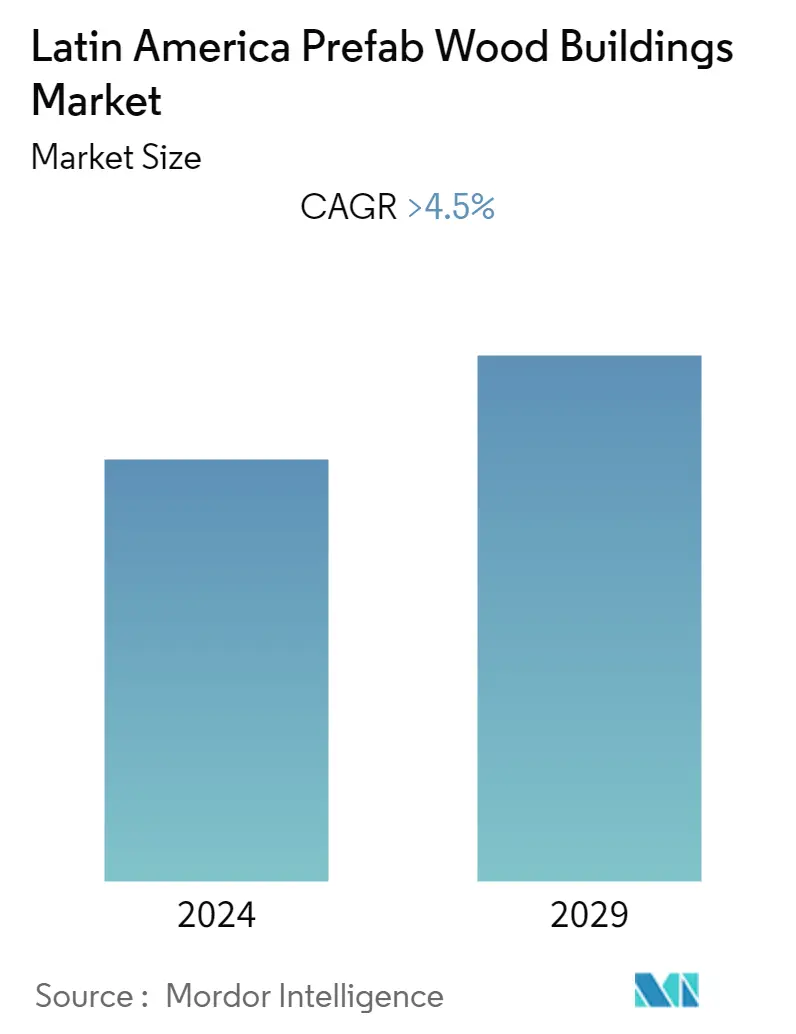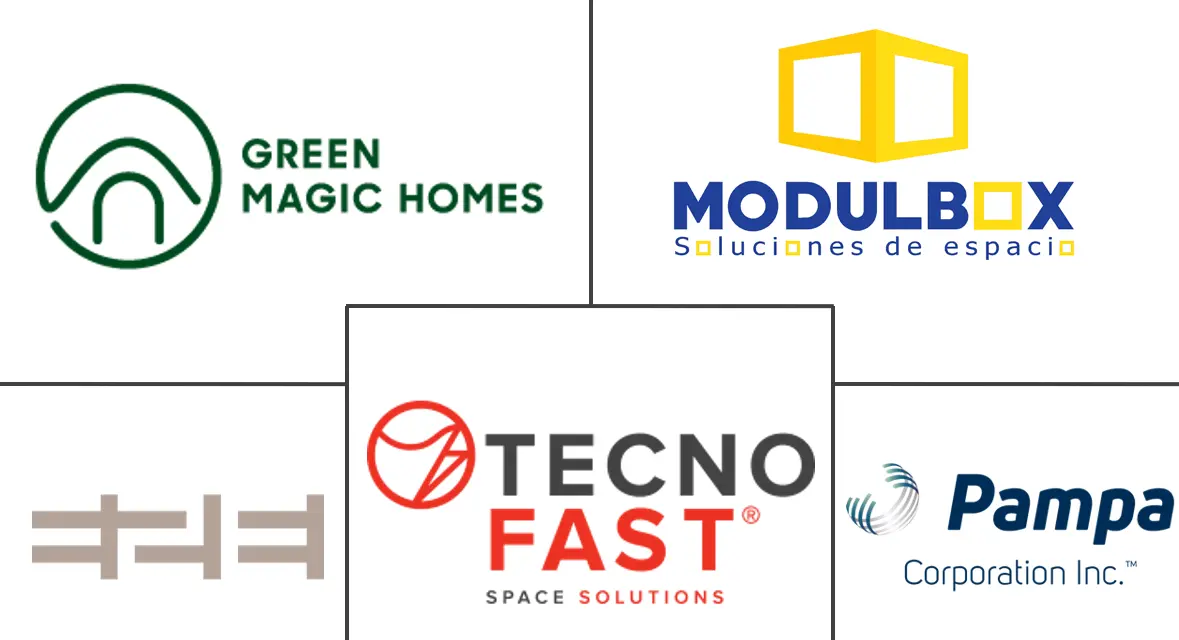Market Size of Latin America Prefab Wood Buildings Industry

| Study Period | 2020 - 2029 |
| Base Year For Estimation | 2023 |
| Forecast Data Period | 2024 - 2029 |
| Historical Data Period | 2020 - 2022 |
| CAGR | > 4.50 % |
| Market Concentration | Medium |
Major Players
*Disclaimer: Major Players sorted in no particular order |
Latin America Prefab Wood Buildings Market Analysis
The Latin America Prefab Wood Buildings Market is expected to grow at a CAGR of more than 4.5% during the forecast period.
- Contractors and suppliers in South America's construction sector are experiencing extreme uncertainty as a result of the COVID-19 outbreak. Lockdowns and limitations forced some construction businesses to halt their projects.
- Before the industrial revolution, wood was the most important building material. During the last two centuries, however, wood has often been replaced by concrete, bricks, steel, and also plastics. However, these materials have a significant negative impact on the environment. To prevent this, more construction companies are considering using bio-based materials such as wood. Sustainable timber provides a more ecologically acceptable cladding material than manufactured panels, and the variations in hue provided by natural wood can provide a dynamic aesthetic to any green building. Governments are striving to use more bio-based building materials, including wood.
- The market for prefab wooden structures has an opportunity due to recent increases in the cost of traditional construction methods and the growth of green buildings in the region. In the first half of 2022, the costs of the construction industry in Brazil increased by 7.53%. In June 2022, there was an increase of 2.14% in the INCC, which corresponds to the third largest increase for that month in the last 28 years. According to the Mexican Chamber of the Construction Industry (CMIC), the cost of building materials, such as rebar, steel, and cement, increased 15% to 25% from December 2021 to April 2022. In addition to the building materials prices, the labor costs increased by 20% in Mexico.
- In February 2022, the U.S. Green Building Council (USGBC) announced Mexico ranks ninth in the world on its annual list of Top 10 Countries and Regions for LEED in 2021. Brazil is the other Latin American country to make the 2021 list and ranked number seven. Both countries represent the ever-growing international demand for certified LEED green buildings that help reduce environmental impact and support health and well-being.
Latin America Prefab Wood Buildings Industry Segmentation
Prefabricated wood building kits are built from prefabricated parts that are delivered and fitted on-site, making them resemble life-size Legos. Prefabricated panels are most frequently used to manufacture whole parts of a building, including glazing packages, roofing components or structure (ceiling, decking, and beams), and building structure (wall panels, beams, columns, and shear paneling).
A complete assessment of the Latin America Prefab Wood Buildings Market includes an assessment of the economy market overview, market size estimation for key segments, and emerging trends in the market segments in the report. The report sheds a light on the market trends like growth factors, restraints, and opportunities in this sector. The competitive landscape of the Latin America Prefab Wood Buildings Market is depicted through the profiles of active key players. The report also covers the impact of COVID-19 on the market and future projections.
The Latin America Prefab Wood Buildings Market is segmented By Application (Residential, Commercial, Industrial), and by Geography (Brazil, Mexico, Argentina, Colombia, Chile, Rest of Latin America). For each segment, the market sizing and forecasts have been done on the basis of value (USD billion).
| By Application | |
| Residential | |
| Commercial | |
| Industrial |
| By Geography | |
| Brazil | |
| Mexico | |
| Argentina | |
| Colombia | |
| Chile | |
| Rest of Latin America |
Latin America Prefab Wood Buildings Market Size Summary
The Latin America prefab wood buildings market is poised for significant growth, driven by a shift towards sustainable construction practices and the increasing adoption of bio-based materials like wood. This transition is partly a response to the environmental impact of traditional building materials such as concrete, steel, and plastics. The market is benefiting from the rising costs of conventional construction methods and the growing demand for green buildings, particularly in countries like Brazil and Mexico, where the costs of building materials and labor have seen substantial increases. The integration of wood as a structural element is gaining traction, especially in urbanized regions like Chile, where high-rise constructions traditionally rely on concrete. The use of wood not only reduces CO2 emissions but also aligns with the global trend towards sustainability in the construction industry.
The popularity of prefabricated wooden houses is on the rise, offering advantages such as cost-effectiveness, ease of installation, and reduced environmental impact. This trend is particularly evident in Mexico, where modular homes are becoming a preferred choice due to their affordability and quick construction times. The demand for prefab wood buildings is further fueled by the housing crisis in major cities like Sao Paulo and Colombia, where there is a pressing need for affordable housing solutions. The market is characterized by a fragmented landscape with key players like Green Magic Homes, VMD, and Modulbox leading the charge. As investments in prefab construction increase and significant projects emerge across the region, the Latin America prefab wood buildings market is expected to expand, offering new opportunities for developers and investors alike.
Latin America Prefab Wood Buildings Market Size - Table of Contents
-
1. Market Insights and Dynamics
-
1.1 Market Overview
-
1.2 Market Dynamics
-
1.2.1 Drivers
-
1.2.2 Restraints
-
1.2.3 Opportunities
-
-
1.3 Industry Attractiveness Porters Five Forces
-
1.4 Value Chain/Supply Chain Analysis
-
1.5 Technological Advancements
-
1.6 Government Regulations and Initiatives
-
1.7 Impact of COVID-19 on the market (Short-term and Long-term Impact on the Market and on the Economy)
-
-
2. Market Segmentation
-
2.1 By Application
-
2.1.1 Residential
-
2.1.2 Commercial
-
2.1.3 Industrial
-
-
2.2 By Geography
-
2.2.1 Brazil
-
2.2.2 Mexico
-
2.2.3 Argentina
-
2.2.4 Colombia
-
2.2.5 Chile
-
2.2.6 Rest of Latin America
-
-
Latin America Prefab Wood Buildings Market Size FAQs
What is the current Latin America Prefab Wood Buildings Market size?
The Latin America Prefab Wood Buildings Market is projected to register a CAGR of greater than 4.5% during the forecast period (2024-2029)
Who are the key players in Latin America Prefab Wood Buildings Market?
Green Magic Homes, VMD, Modulbox, E2E Chile and Techno Fast are the major companies operating in the Latin America Prefab Wood Buildings Market.

